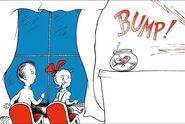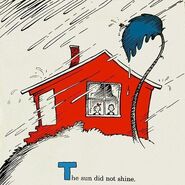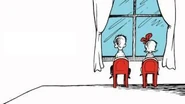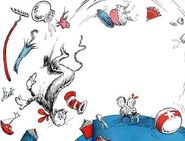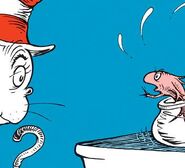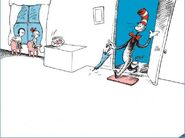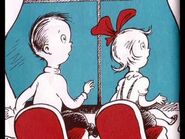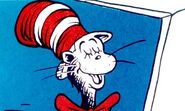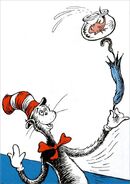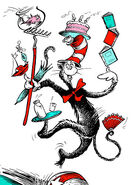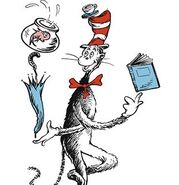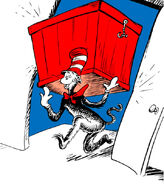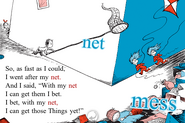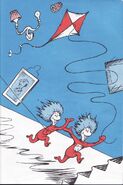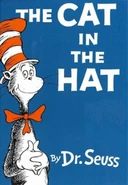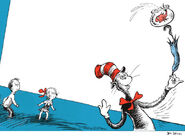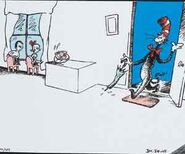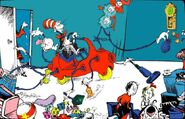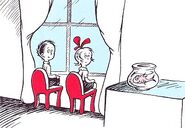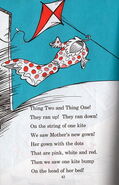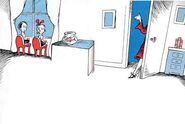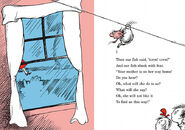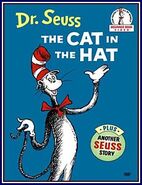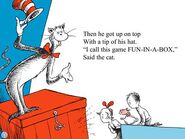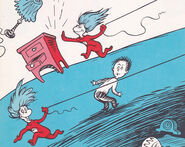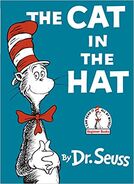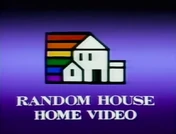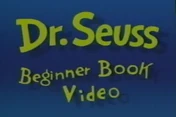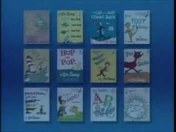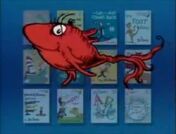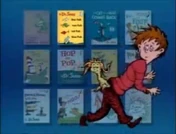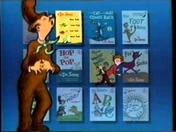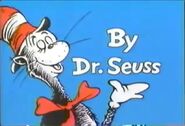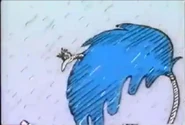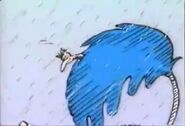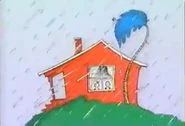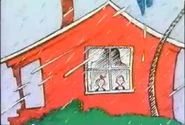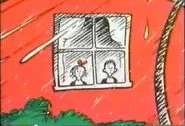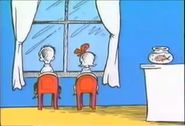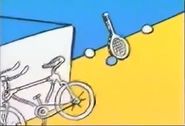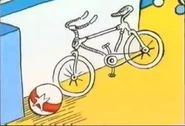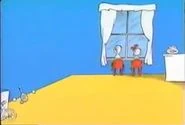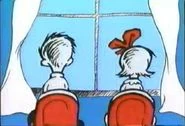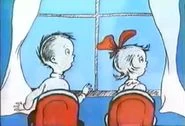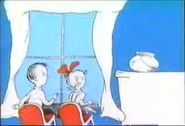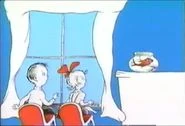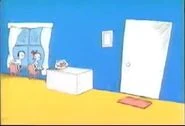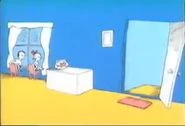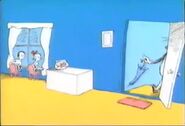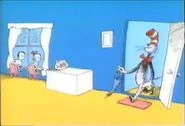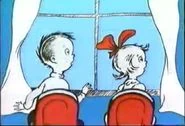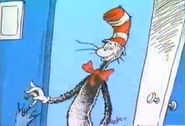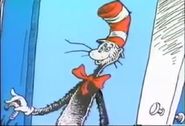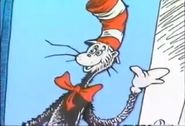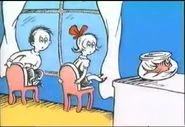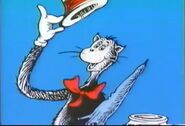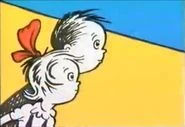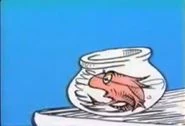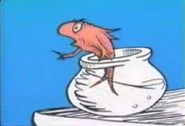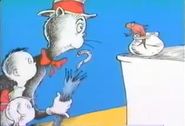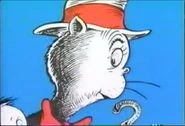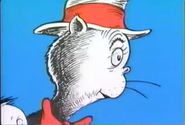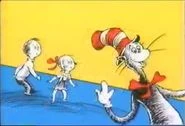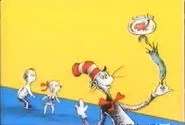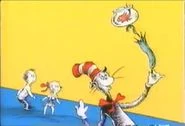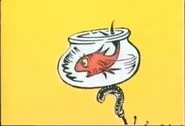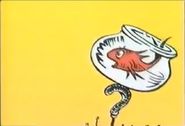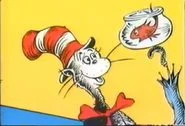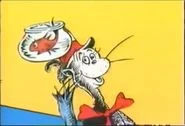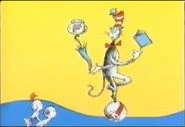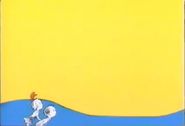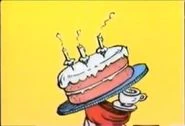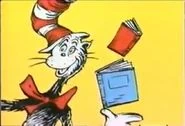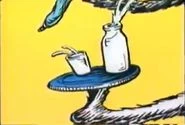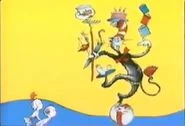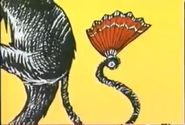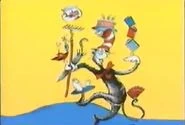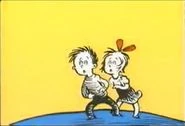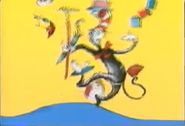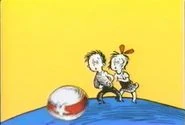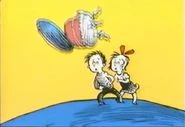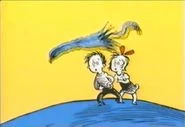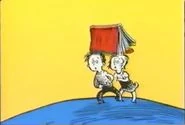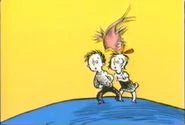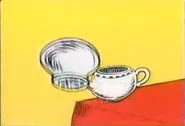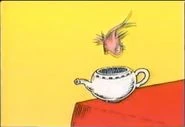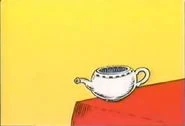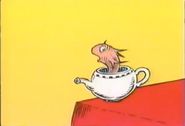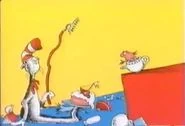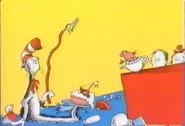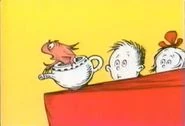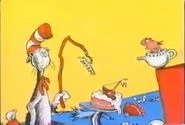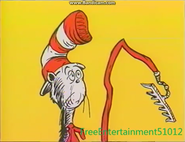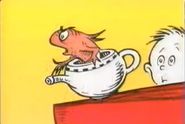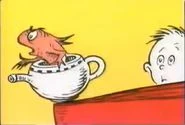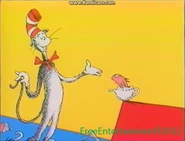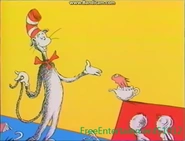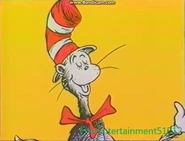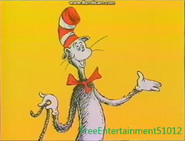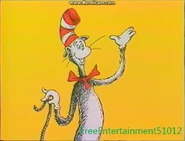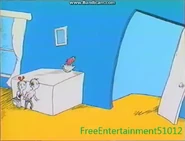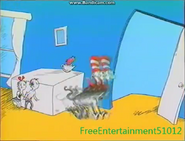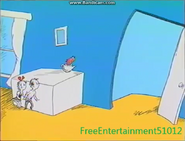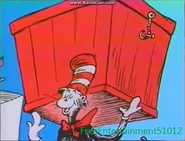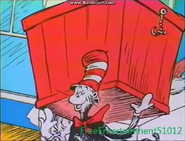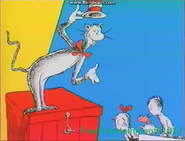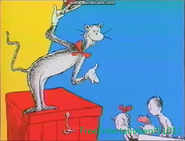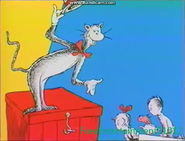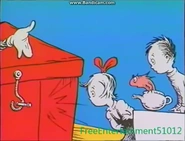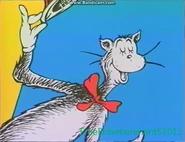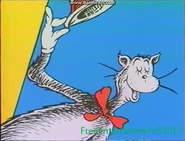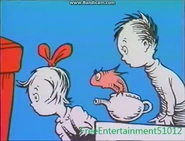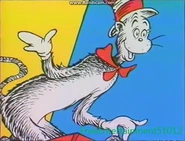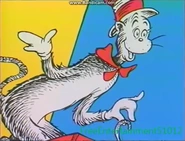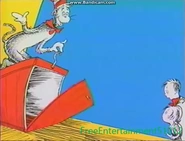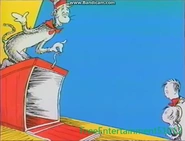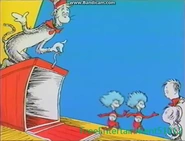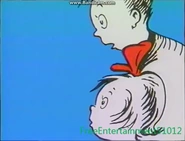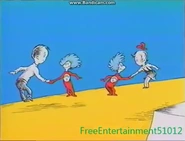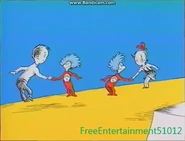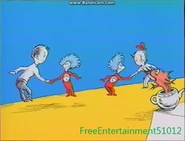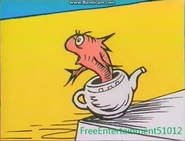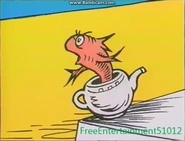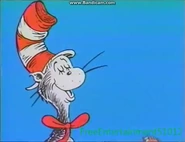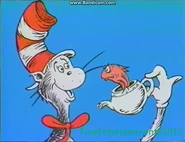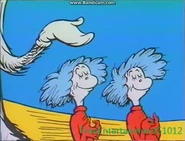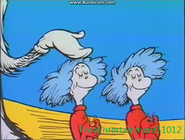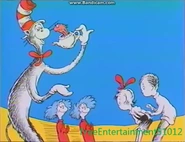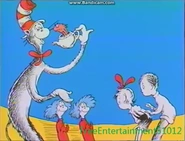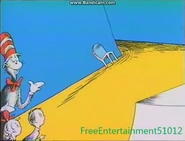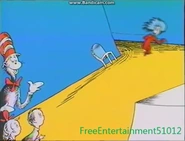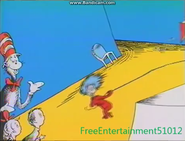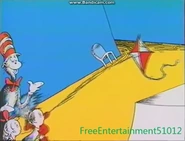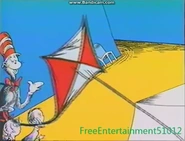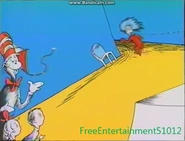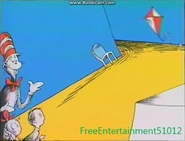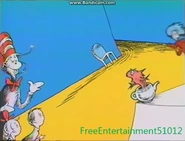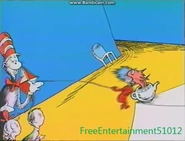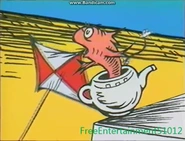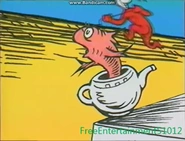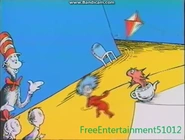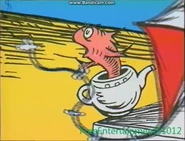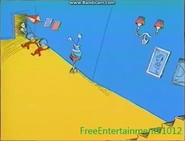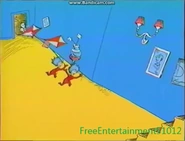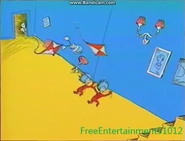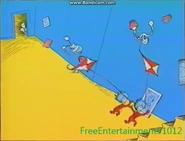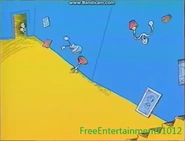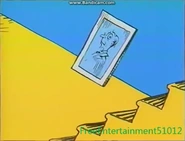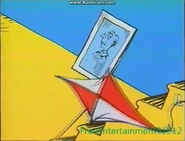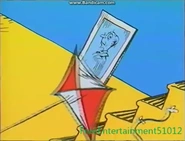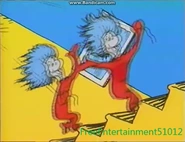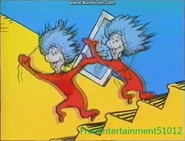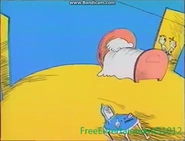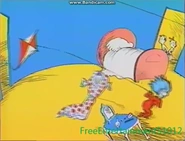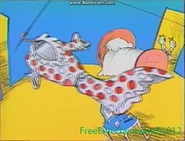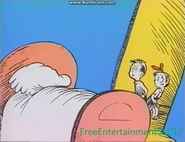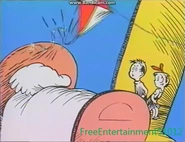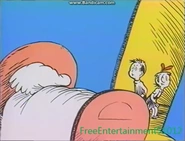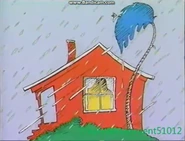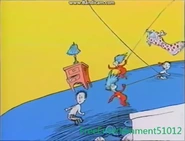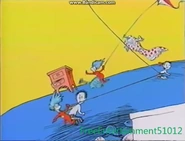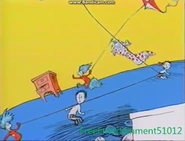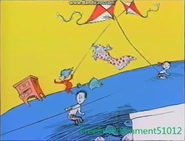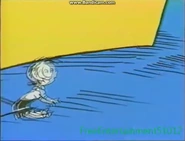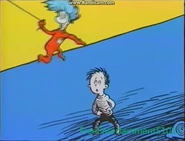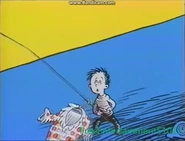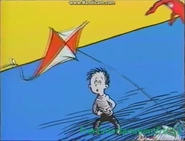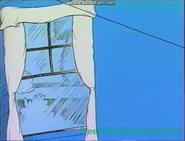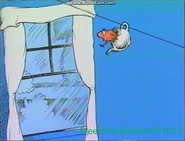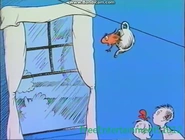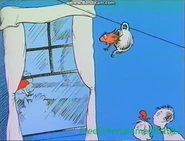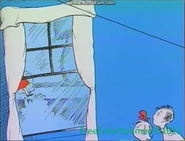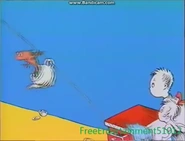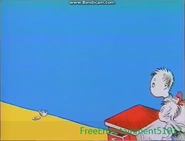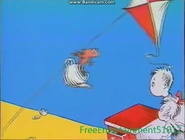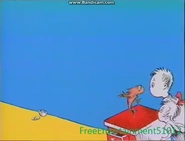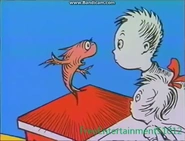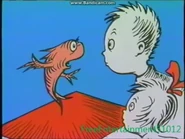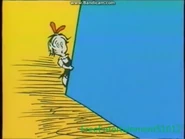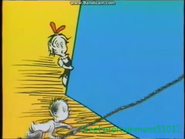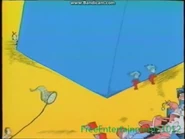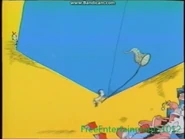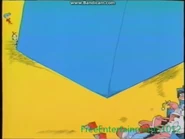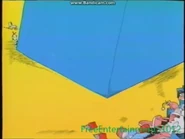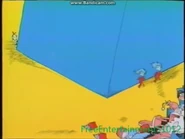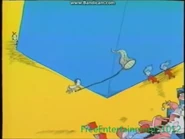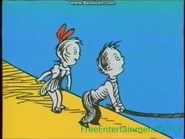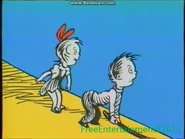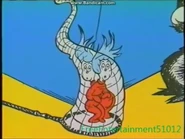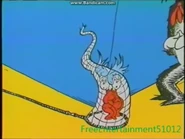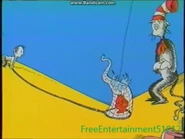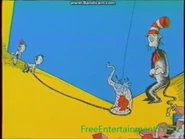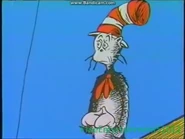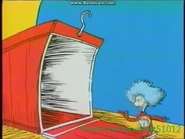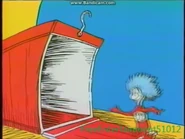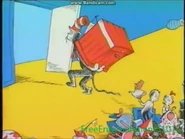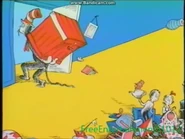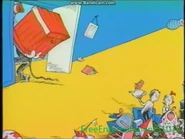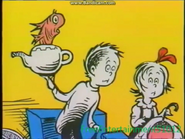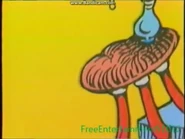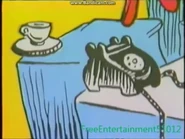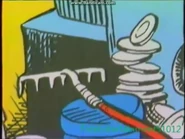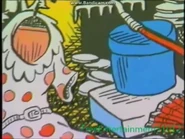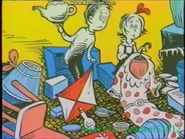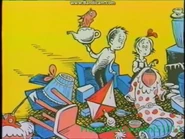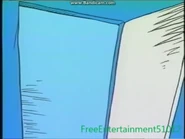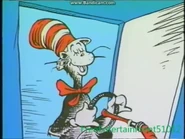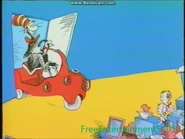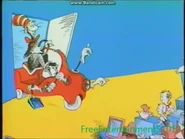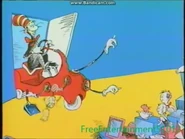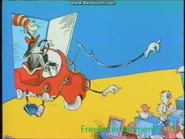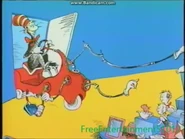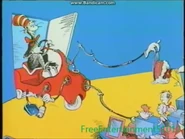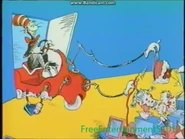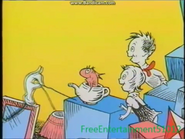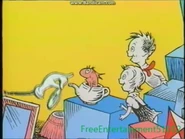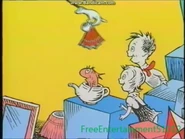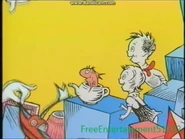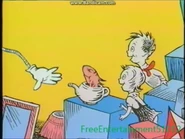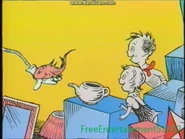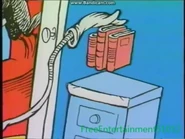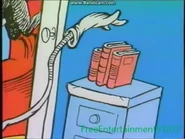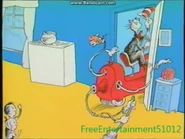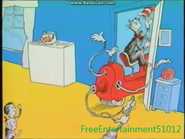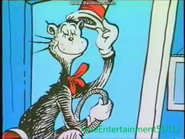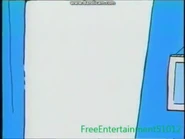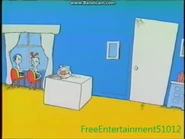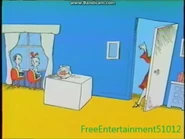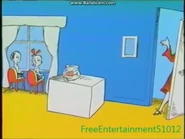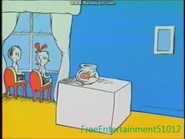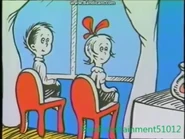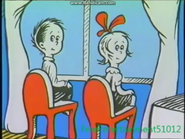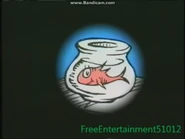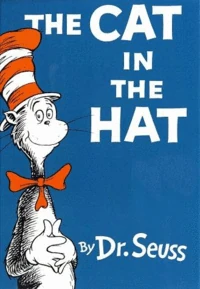 The Cat in the Hat is a children's book by Dr. Seuss, featuring a tall, anthropomorphic, mischievous cat, wearing a tall, red and white striped hat. With the series of Beginner Books that The Cat inaugurated, Seuss promoted both his name and the cause of elementary literacy in the United States.[1] The eponymous cat appears in six of Seuss's rhymed children's books.
The Cat in the Hat is a children's book by Dr. Seuss, featuring a tall, anthropomorphic, mischievous cat, wearing a tall, red and white striped hat. With the series of Beginner Books that The Cat inaugurated, Seuss promoted both his name and the cause of elementary literacy in the United States.[1] The eponymous cat appears in six of Seuss's rhymed children's books.
This book has an iOS and Android app by Oceanhouse Media.
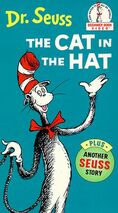
Beginner Book Video
This book was also used in the Random House Home Video Series which entitles "Dr. Seuss Beginner Book Video" featuring "Maybe You Should Fly a Jet! Maybe You Should Be a Vet!"
In the Two Dr. Seuss Favorites, This book is featured after Green Eggs and Ham.
History
Theodore Geisel, writing as Dr. Seuss, created The Cat in the Hat in response to the May 24, 1954 Life magazine article by John Hersey, titled "Why Do Students Bog Down on First R? A Local Committee Sheds Light on a National Problem: Reading." In the article, Hersey was critical of school primers:
In the classroom boys and girls are confronted with books that have insipid illustrations depicting the slicked-up lives of other children. [Existing primers] feature abnormally courteous, unnaturally clean boys and girls. . . . In bookstores, anyone can buy brighter, livelier books featuring strange and wonderful animals and children who behave naturally, i.e., sometimes misbehave. Given incentive from school boards, publishers could do as well with primers.
Hersey’s arguments were enumerated over ten pages of Life Magazine, which was the leading periodical during that time. After detailing many issues contributing to the dilemma connected with student reading levels, Hersey asked toward the end of the article:
Why should [school primers] not have pictures that widen rather than narrow the associative richness the children give to the words they illustrate — drawings like those of the wonderfully imaginative geniuses among children’s illustrators, Tenniel, Howard Pyle, "Dr. Seuss", Walt Disney?
Dr. Seuss responded to this "challenge," and began work. His publisher supplied him with the sight vocabulary of 223 words, one that was in harmony with the words the child would be learning in school.
In an interview he gave in Arizona magazine in June 1981, Dr. Seuss claimed the book took nine months to complete due to the difficulty in writing a book from the 223 selected words. He added that the title for the book came from his desire to have the title rhyme and the first two suitable rhyming words that he could find from the list were "cat" and "hat". Dr. Seuss also regretted the association of his book and the "look say" reading method adopted during the Dewey revolt in the 1920s. He expressed the opinion that "... killing phonics was one of the greatest causes of illiteracy in the country."
The Cat in the Hat
In the first book featuring the character (The Cat in the Hat, 1957), the Cat brings a cheerful, exotic and exuberant form of chaos to a household of two young children one rainy day while their mother is out. Bringing with him two creatures appropriately named Thing One and Thing Two, the Cat performs all sorts of wacky tricks to amuse the children, with mixed results. The Cat's antics are vainly opposed by the family pet, who is a sentient and articulate goldfish. The children (Sally and her older brother, who serves as the narrator) ultimately prove exemplary latchkey children, capturing the Things and bringing the Cat under control. He cleans up the house on his way out, disappearing seconds before the mother arrives.
The book has been popular since its publication, and a logo featuring the Cat adorns all Dr. Seuss publications and animated films produced after Cat in the Hat.
Seuss wrote the book because he felt that there should be more entertaining and fun material for beginning readers. From a literary point of view, the book is a feat of skill, since it simultaneously maintains a strict triple meter, keeps to a tiny vocabulary, and tells an entertaining tale. Literary critics occasionally write recreational essays about the work, having fun with issues such as the absence of the mother and the psychological or symbolic characterizations of Cat, Things, and Fish. This book is written in a style common to Dr. Seuss, anapestic tetrameter (see Dr. Seuss's meters).
The Cat in the Hat has also been translated into Latin with the title Cattus Petasatus and into Yiddish with the title "di Kats der Payats".
The story is 1626 words in length and uses a vocabulary of only 223 distinct words, of which 54 occur exactly once and 33 twice. Only a single word – another – has three syllables, while 14 have two and the remaining 221 are monosyllabic. The longest words are something and playthings.
The Cat in the Hat has gone on to sell 7.2 million copies in the United States alone (up to 2000), making it the 9th best-selling hardcover children's book of all time.
The Cat in the Hat Comes Back
The Cat in the Hat made a return appearance in this 1958 sequel. He returns to the Walden's house where Conrad and Sally are seen working in the snow with shovels not having time for the Cat's bad tricks again. On this occasion, he leaves Thing One and Thing Two at home, but does bring along Little Cat A, nested inside his hat. Little Cat A doffs his hat to reveal Little Cat B, who in turn reveals C, and so on down to the microscopic Little Cat Z, who turns out to be the key to the plot of the problems being solved. The crisis involves a pink bathtub ring and other pink residue left by the Cat. So the Little Cats from the Big cat's hat are working hard. At the end, during little Cat Z's vooming process all the cats are blown back into the the Cat's magical hat.
The book ends in a burst of flamboyant versification, with the full list of little cats arranged into a metrically-perfect rhymed quatrain. It teaches the reader the alphabet.
Little Cats A, B and C were also characters in the 1996 TV series The Wubbulous World of Dr. Seuss.
The Cat in The Hat Comes Back was part of the Beginner Book Video series along with There's a Wocket in my Pocket! and Fox in Socks.
Adrian Edmondson narrated both Cat in the Hat stories for a HarperCollins audiobook that also includes Fox in Socks and Green Eggs and Ham.
Beginner Books
The Cat in the Hat was published by Random House. However because of its success, an independent publishing company was formed, called Beginner Books. DGeisel was the president and editor. Beginner Books was chartered as a series of books oriented toward various stages of early reading development. (From 1957 to 1960, Random House was the distributor of Beginner Books. In 1960, Random House purchased Beginner Books, and it became a division of Random House.[2]) The second book in the series was nearly as popular, The Cat in the Hat Comes Back, published in 1958.
Springing from this series of beginning readers were such standards as A Fly Went By (1958), Sam and the Firefly (1958), Green Eggs and Ham (1960), Go, Dog. Go! (1961), Hop on Pop (1963), and Fox in Socks (1965), each a monument in the picturebook industry, and also significant in the historical development of early readers. All are still in print and remain very popular over forty years after their initial publication.
Creators in the Beginner Book series were such luminaries as Jan & Stan Berenstain, P. D. Eastman, Roy McKie, and Helen Palmer (Mr. Geisel’s wife). The Beginner Books dominated the children’s picturebook market of the 1960’s, and still plays a significant role today within the phases of students’ reading development. The early success of Beginner Books, both from a commercial and learn-to-read perspective, initiated the blurring between educational and entertainment books.[3]
The Cat in the Hat's Learning Library
Starting in 1998, Random House has been releasing books in a book series titled "The Cat in the Hat's Learning Library." In each book, the Cat in the Hat, along with Thing 1 and Thing 2, shows up and teaches Dick (the boy's name in The Cat in the Hat was not revealed, but the 1971 animated special suggested it was Conrad) and Sally the many things the book's topic covers. There are even side notes that are narrated by Thing 1 and Thing 2. In the book Clam-I-Am, the Cat in the Hat takes a break, and Dick and Sally's beloved pet, Norval the Fish, along with the Cat in the Hat and the Things, teaches the children about life at the beach.
At the end of each book, after the Cat in the Hat's teaching is done, there is a glossary on some of the words used, an index, and a list of suggested books, from other publishers, that cover the topic each book covered.
While the illustrators leave the original outfits of Dick and Sally intact, they've made changes to Thing 1 and Thing 2. In the original "The Cat in the Hat" book and the special, Thing 1 and Thing 2 had plain white skin and blue hair and wore red sleepers. In "The Cat in the Hat's Learning Library," the illustrators have changed the Things' appearance so that they have pink skin and yellow hair and wear blue sleepers.
See list of The Cat in the Hat's Learning Library books
Adaptations
Television
Template:Main
Film
Template:Main
Seussical The Musical
Seussical the Musical is a musical that combines different Dr. Seuss stories together. The Cat In The Hat plays the narrator, as well as a few minor characters.
Educational CD game
Living Books has created an educational CD game of the story, guided by animated characters. Software MacKiev brought this electronic version of the book to the Mac OS X.
Ride
A ride was built based upon the book in Seuss Landing in Islands of Adventure in 1999.
Audio-book
You can listen to the audio-book here: https://www.youtube.com/watch?v=XhqsfkXTcH8
You can read the book online here: https://www.youtube.com/watch?v=vc8E5qMAtMA
Parodies
- A book called "The Cat NOT in the Hat!" written by a fictional "Dr. Juice" was published by Penguin Books USA in 1995. The book depicted O.J. Simpson resembling the Cat in the Hat and describing his perspective on his murder trial with verses such as, "A man this famous/Never hires/Lawyers like/Jacoby Meyers/When you're accused of a killing scheme/You need to build a real Dream Team" and "One knife?/Two knife?/Red knife/Dead wife." Dr. Seuss' widow, Audrey Geisel, sued Penguin Books, arguing that the work infringed the copyright to her husband's work. The court agreed and enjoined Penguin Books from distributing the book. [4]
- Freud on Seuss is a humorous short essay on the symbolism of The Cat in the Hat. [1]
- In an episode of The Fairly OddParents, Timmy reads a book called "The Rat in Spats", which is illustrated much like Dr. Seuss. The Rat in Spats is similar to Pinky and Phar Fig Newton from Pinky and the Brain.
- In an episode of The Angry Beavers, an animal called "The Yak in the Sak" appears. This is most likely a parody on the cat in the hat.
- The Cat in the Hat appeared as the protagonist in The Wubbulous World of Dr. Seuss.
- The Cat in the Hat appeared in the Family Guy episode "Dammit Janet!" When he offers to clean up young Peter Griffin's house, Peter tells him to leave the mess as he wants to see the look on his parents faces when they get home.
- A different version of the Cat in the Hat appeared in the Robot Chicken episode "Endless Breadsticks" voiced by Seth Green. In a segment that parodied "Seussical the Musical,".
- In the movie Borat, when Borat wants to buy a pet, he sees a turtle and calls it a "Cat in the Hat".
Quoted in the U.S. Senate
In the 110th Congress, Senate Majority Leader Harry Reid compared the impasse over a bill to reform immigration with the mess created by the Cat in The Cat in the Hat. He read lines of the book from the Senate floor, quoting "'That is good,' said the fish. 'He's gone away, yes. But your mother will come. She will find this big mess.'"[5] He then carried forward his analogy hoping the impasse would be straightened out for "If you go back and read Dr. Seuss, the cat manages to clean up the mess."[6] Reid's hopes did not come about for as one analyst put it "the Cat in the Hat did not have to contend with cloture."[5]
Film and other appearances
In the Tom Clancy film Patriot Games (1992), Jack Ryan visits his daughter, Sally, in her hospital room and reads to her from The Cat in the Hat, which features a character named Sally: "I sat there with Sally." Later, he is reading it by himself in the hospital cafeteria, when Provisional Irish Republican Army (PIRA) leader Paddy O'Neill walks in with a gift for Ryan.
The book makes a cameo appearance in the Nick Jr. show Wonder Pets intro where it can be seen between the books. Also when Tuck is swimming.
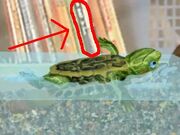
Book's cameo appearance in Wonder Pets.
Editions
All were published by Random House. The original edition was a joint publication with Houghton Mifflin.
- The Cat in the Hat:
- First Edition
The first edition was published in 1957, prior to the establishment of ISBNs. The first edition can be identified by the '200/200' in the top right corner of the front dust jacket flap, signifying the $2.00 selling price. The Cat In The Hat sold for $2.00 for the first year of publication, then was reduced to $1.95 with the establishment of Beginner Books in 1958.
According to the Children's Picturebook Price Guide, 2006-2007 edition, The first edition Cat In The Hat has an estimated market value of $4000.
- ISBN 0-394-80001-X (hardcover, 1957, Large Type Edition)
- ISBN --none------- (hard cover, 1957, Book Club Edition)
- ISBN 0-394-90001-4 (library binding, 1966, Large Type Edition)
- ISBN 0-394-89218-6 (hardcover with audio cassette, 1987)
- ISBN 0-679-86348-6 (hardcover, 1993)
- ISBN 0-679-89267-2 (hardcover, 1999)
- The Cat in the Hat Comes Back:
- ISBN 0-394-80002-8 (hardcover, 1958)
- The Annotated Cat: Under the Hats of Seuss and His Cats introduction and annotations by Philip Nel
- ISBN 978-0-375-83369-4 (hardcover, 2007)
Goofs, Errors, and Corrections of the book and video
Gallery
Video Book, which also includes Maybe You Should Fly a Jet! Maybe You Should Be a Vet!
Video Book Gallery
No More of the pictures from this video coming soon. Stay tuned.

